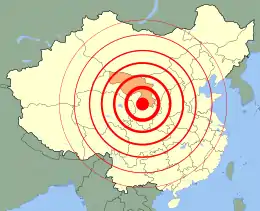1920 Haiyuan earthquake
1920 Haiyuan earthquake (Chinese: 海原大地震; pinyin: Hǎiyuán dà dìzhèn) occurred on December 16 in Haiyuan County, Ningxia Province, Republic of China. It was also called the 1920 Gansu earthquake[1] because Ningxia was a part of Gansu Province when the earthquake occurred. It caused destruction in the Lijunbu-Haiyuan-Ganyanchi area and was assigned the maximum intensity on the Mercalli intensity scale – (XII Extreme).
 | |
| UTC time | 1920-12-16 12:05:55 |
|---|---|
| ISC event | 912687 |
| USGS-ANSS | ComCat |
| Local date | December 16, 1920 (Gansu-Sichuan Time) |
| Local time | 19:05 |
| Magnitude | 7.8 ML[1] |
| Epicenter | 36.50°N 105.70°E |
| Fault | Haiyuan Fault |
| Max. intensity | XII (Extreme)[2] |
| Landslides | >50,000[2] |
| Casualties | 200,000[1]–273,400[3][4] |
Earthquake
The earthquake hit at 19:05:53 Gansu-Sichuan time (12:05:53 UTC),[5] reportedly 7.8 on the Richter magnitude scale, and was followed by a series of aftershocks for three years. Today's Chinese media claim the earthquake was of magnitude 8.5, although the seismic scale is not specified.
Damage
Over 73,000 people were killed in Haiyuan County. A landslide buried the village of Sujiahe in Xiji County. More than 30,000 people were killed in Guyuan County.[2] Nearly all the houses collapsed in the cities of Longde and Huining. Damage (VI–X) occurred in seven provinces and regions, including the major cities of Lanzhou, Taiyuan, Xi'an, Xining and Yinchuan. It was felt from the Yellow Sea to Qinghai (Tsinghai) Province and from Nei Mongol (Inner Mongolia) south to central Sichuan Province.
Casualties
Total casualties were reported as 200,000 in a summary published by the United States Geological Survey,[1] and 235,502 according to the Catalog of Damaging Earthquakes in the World (through 2008) maintained by the International Institute of Seismology and Earthquake Engineering.[3] Many more perished because of cold: frequent aftershocks caused the survivors to fear building anything other than temporary shelters, and a severe winter killed many who had lived through the original earthquake.[6] Chinese seismologists published a revised estimate in 2010 of 273,400 deaths.[3][4]
The Sufi Jahriyya Muslim Hui leader Ma Yuanzhang and his son died in the earthquake when the roof of the Mosque they were in collapsed in Zhangjiachuan.[7][8]
Ground effects
About 230 km (140 mi) of surface faulting was seen from Lijunbu through Ganyanchi to Jingtai. There were more than 50,000 landslides in the epicentral area and ground cracking was widespread. Some rivers were dammed; others changed course.[9] Seiches from this earthquake were observed in two lakes and three fjords in western Norway.[1]
Aftermath
The Muslim General Ma Fuxiang was involved in relief efforts in Lanzhou during the earthquake.[10][11][12]
References
- "Most Destructive Known Earthquakes on Record in the World". Earthquake.usgs.gov. Archived from the original on 2009-09-01. Retrieved 2011-10-26.
- Xu, Y.; Liu–Zeng, J.; Allen, M.B.; Zhang, W.; Du, P. (2020). "Landslides of the 1920 Haiyuan earthquake, northern China". Landslides. doi:10.1007/s10346-020-01512-5. S2CID 221568806.
- "Death Toll of 1920 China Earthquake Higher than Previously Estimated". Xinhua News Agency. 16 December 2010. Archived from the original on 2013-01-11. Retrieved 2012-12-27.
- Chen, Na (21 December 2010). "Death Toll of 1920 China Earthquake Higher than Previously Estimated". Chinese Academy of Sciences. Retrieved 2020-09-22.
- "Significant earthquake". The Significant Earthquake Database. National Geophysical Data Center. Retrieved 2013-06-15.
- Close, Upton, and Elsie McCormick. "Where the Mountains Walked". National Geographic 41.5 (1922): 445–464: 451.
- Jonathan Neaman Lipman (1997). Familiar Strangers: A History of Muslims in Northwest China. Seattle: University of Washington Press. p. 184. ISBN 978-0-295-97644-0.
- University of Illinois at Urbana-Champaign. Center for Asian Studies (1979). Chinese Republican studies newsletter, Volumes 5-7. p. 34.
- Liu-Zeng, J.; Shao, Y.; Klinger, Y.; Xie, K.; Yuan, D.; Lei, Z. (2015). "Variability in magnitude of paleo-earthquakes revealed by trenching and historical records, along the Haiyuan fault". Journal of Geophysical Research: Solid Earth. 120: 8301–8333. doi:10.1002/2015JB012163.
- "马福祥--"戎马书生" – 新华网甘肃频道". Archived from the original on 2015-09-24. Retrieved 2014-10-30.
- "缅怀中国近代史上的回族将领马福祥将军戎马一生". Archived from the original on 2014-10-30. Retrieved 2014-10-30.
- "清末民国间爱国将领马福祥__中国甘肃网". Archived from the original on 2015-09-24. Retrieved 2014-10-30.
Further reading
- Xu, Xiurong; Zhang, Zhenguo; Hu, Feng; Chen, Xiaofei (2019), "Dynamic Rupture Simulations of the 1920 Ms 8.5 Haiyuan Earthquake in China", Bulletin of the Seismological Society of America, 109 (5): 2009–2020, doi:10.1785/0120190061
External links
- The International Seismological Centre has a bibliography and/or authoritative data for this event.
![]() This article incorporates public domain material from websites or documents of the United States Geological Survey.
This article incorporates public domain material from websites or documents of the United States Geological Survey.